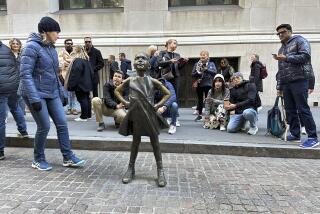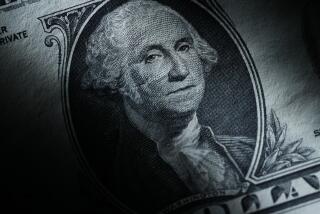Could a Rise in CD Rates Cause Another Crash?
- Share via
The shock of lower interest rates should be wearing off bank and S&L; customers by now. Yet they’re still abandoning their certificates of deposit at a brisk pace and taking that money elsewhere--often to stock or bond mutual funds.
The ongoing CD outflow is bolstering the argument that many Americans have successfully made the leap from simply being “savers” to being investors. Wall Street’s bulls say there’s no going back for those folks. But then, the bulls better pray that’s true: If ex-savers pour back into CDs just as soon as rates start to climb again, stock and bond markets could be devastated.
The dramatic slide in CD yields began about a year ago. Between September, 1991, and March of this year, the average yield on one-year CDs nationwide dropped 1.69 percentage points, from 5.81% to 4.12%, according to the newsletter Bank Rate Monitor in North Palm Beach, Fla.
The slide has continued over the last six months, but at a much slower rate. The average one-year CD yield now: 3.53%, down 0.59 points from March.
By now, most people aren’t surprised by 3% to 4% savings rates. So when putting new money to work or rolling over, say, a six-month CD, many savers’ anger and disappointment of last winter and spring may amount to mere resignation today. You get used to it--or so the experts figured.
Yet the Federal Reserve’s tally of savings trends suggests that there’s been no halt to the CD outflow. Between Aug. 10 and 17, for example, the total amount in small (under $100,000) CDs at banks and S&Ls; fell $3.5 billion, to $927 billion.
That pace of $3 billion to $4 billion in weekly outflows has been going on for most of the last year, pulling a net $190 billion out of CDs since September, 1991. Obviously, that is a very large chunk of change.
And mutual funds have nabbed a significant share of those dollars, as savers trade their super-safe CDs for what they hope will be much higher returns in stock or bond funds.
Michael Hines, senior vice president at mutual fund giant Fidelity Investments in Boston, says the shock of falling interest rates may indeed be wearing off as the rate of decline slows. But savers still have to deal with another form of rate shock, he says, which is that “we have the lowest nominal yields (on CDs) in two decades.”
In other words, even if the saver believes that one-year CD yields have stabilized at 3.5%, that doesn’t change the fact that 3.5% is a terrible return. So people look elsewhere.
Ironically, banks and S&Ls; themselves are aiding the deposit outflow.
Many institutions now employ in-branch brokers who sell mutual funds, annuities and other long-term investments that yield far more than CDs. When a saver decides to terminate a CD, the bank or S&L; manager just walks the person over to the sales rep.
At California Federal Bank, for example, spokesman James Hurley says his institution expects to produce sales of $800 million in alternative investment products this year. Typically, a bank or S&L; selling another company’s products gets a cut of the commission. If the deposit is going to walk out the door anyway, a commission is better than nothing.
But there’s another side to that product cross-selling: When CD yields begin to rise again, the bank or S&L; that helped its former savers into mutual funds will be there to help them out , and back into CDs.
Given the extent of the CD outflow over the last two years, the prospect of a mass exodus by those ex-savers--out of stocks and bonds, and into CDs--raises the specter of a crash that could be far worse than what Wall Street saw in October, 1987.
The mutual fund industry believes that those worries are overblown. “If rates do kick up again, some money will go” back to the banks, says Fidelity’s Hines. But he insists that Americans’ progression away from simple saving, and toward diversified investing in stocks and bonds, is irreversible.
“I think the secular trend is toward mutual funds,” Hines says, and a turnaround in interest rates won’t change that, he adds. Look at money market funds, he says.
Some experts believed that money funds would die out when interest rates fell in the early 1980s and banks offered similar products. Instead, money funds have thrived.
Still, the staying power of ex-savers in stocks and bonds will surely be tested if those markets go awry. For now, however, many rate-watchers believe that the day of reckoning is far off.
Robert Heady, publisher of Bank Rate Monitor, figures that the Fed will cut interest rates again sometime later this month to help the economy. That will bring CD yields down another quarter- to half-percentage point in October and November, he says.
But in 1993, Heady figures rates will have to begin rising again if there’s any kind of economic recovery. That’s why he’s advising subscribers to keep their money in CDs of six months’ term or less, despite the paltry returns. “The next rate cycle is certainly up,” he says. “It’s just a question of how far we’ll go.”
No more ‘Yield Shock’?
Bank and S&L; CD yields have continued yields have continued to slide over the past six months, but the decline has been mild compared to what happened in the previous six months. A look at yield trends at some Southland institutions, versus the national average:
Yield on 1-year CDs: Sept. March Bank/S&L; 1991 1992 Latest BankAmerica 5.55% 3.82% 3.20% CalFed Bank 6.18% 4.45% 4.03% Glendale Fed. 6.13% 4.39% 3.77% HomeFed Bank 6.75% 4.60% 4.08% Home Savings 6.10% 4.39% 3.98% Wells Fargo 5.50% 3.85% 3.20% National average 5.81% 4.12% 3.53%
Source: Times research, Bank Rate Monitor
More to Read
Inside the business of entertainment
The Wide Shot brings you news, analysis and insights on everything from streaming wars to production — and what it all means for the future.
You may occasionally receive promotional content from the Los Angeles Times.










